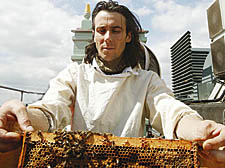| |

Beekeeper Steve Benbow tends to Fortnum and Mason’s as yet not-so-busy bees |
High-flying bees with a low work rate
Fortnum and Mason’s rooftop hives have yet to produce the goods – but all is not lost
WHEN luxurious department store Fortnum and Mason installed four bee hives 100ft up on its Piccadilly roof, some people called them crazy.
But with panoramic views over St Paul’s Cathedral, the Houses of Parliament and Westminster Cathedral, it was hoped the bees would be inspired to make honey fit for Royal palates.
At £10 a pot, it was certainly a wallet stinger
But it seems the bees have not been so busy, and now the famous shop has confessed the much anticipated batch of West End honey will not be ready until Spring next year.
So how did the 40,000 strong swarm find themselves in such a sticky situation? Was the finest nectar in Mayfair not enough?
The colony hasn’t collapsed. There is still a Queen on the throne, but a combination of poor weather and a lack of flowers has meant the workers are temporarily on strike.
Jonathan Miller, sweet grocery buyer at the store, whose idea it was to build the hives said: “The weather over the last few months has meant we won’t have any honey until probably May at the earliest. But it is not catastrophic by any means.
“The idea was only that we would get a bit of honey and then the colony would increase in size. With a bit of good weather we expect our first batch of West End honey to be in pots next year.”
No expense was spared on the 40,000 Carniola bees. Each of the four palatial hives, fit for a sisterhood of Queens, have a different architectural style – with triumphal arch entrances, in Roman, Chinese, Gothic and Mughal designs.
And as befits such a noble institution, the bees are well travelled, having done something of a Royal tour.
They came all the way from Italy, via Harrow, and are said to be a “placid” breed. By next year the hives will have expanded to accommodate 200,000 bees.
While Mr Miller had reservations about putting hives 100ft in the sky, he says the unique setting will give Fortnum’s honey a ‘toffeeish’ taste and unusually fine consistency.
“The bees can just about climb to that height naturally. It was a bit of a barmy idea putting them so high in the sky but their position over Westminster will make them unique. There is actually more variety of flora and fauna in central London than in the countryside and it is free from undesirable plants like rapeseed,” said Mr Miller.
Previously the honey sold in Fortnum’s, known as Rose Petal honey, originated from hives in Oxfordshire and Shropshire. Next summer the stores expects to harvest enough London honey to make around 800 half-pound pots. |
 |
|
 |
| |
| |